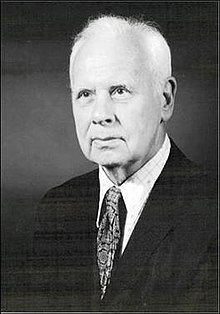George Stibitz
| George Stibitz | |
|---|---|
 |
|
| Born |
April 30, 1904 York, Pennsylvania |
| Died | January 31, 1995 (aged 90) Hanover, New Hampshire |
| Alma mater |
Cornell University Union College Denison University |
| Notable awards |
Harry H. Goode Memorial Award (1965) IEEE Emanuel R. Piore Award (1977) |
George Robert Stibitz (April 30, 1904 – January 31, 1995) is internationally recognized as one of the fathers of the modern first digital computer. He was a Bell Labs researcher known for his work in the 1930s and 1940s on the realization of Boolean logic digital circuits using electromechanical relays as the switching element.
Stibitz was born in York, Pennsylvania. He received his bachelor's degree from Denison University in Granville, Ohio, his master's degree from Union College in 1927, and his Ph.D. in mathematical physics in 1930 from Cornell University.
In November 1937, George Stibitz, then working at Bell Labs, completed a relay-based calculator he later dubbed the "Model K" (for "kitchen table", on which he had assembled it), which calculated using binary addition. Replicas of the "Model K" now reside in the Computer History Museum, the Smithsonian Institution, the William Howard Doane Library at Denison University and the American Computer Museum in Bozeman, Montana where the George R. Stibitz Computer and Communications Pioneer Awards are granted.
Bell Labs subsequently authorized a full research program in late 1938 with Stibitz at the helm. Their Complex Number Computer, completed in November 1939, was able to do calculations on complex numbers. In a demonstration to the American Mathematical Society conference at Dartmouth College in September 1940, Stibitz used a teletype to send commands to the Complex Number Computer in New York over telegraph lines. It was the first computing machine ever used remotely. (See the commemorative plaque and the hall where this event took place in the photos below.)
...
Wikipedia
